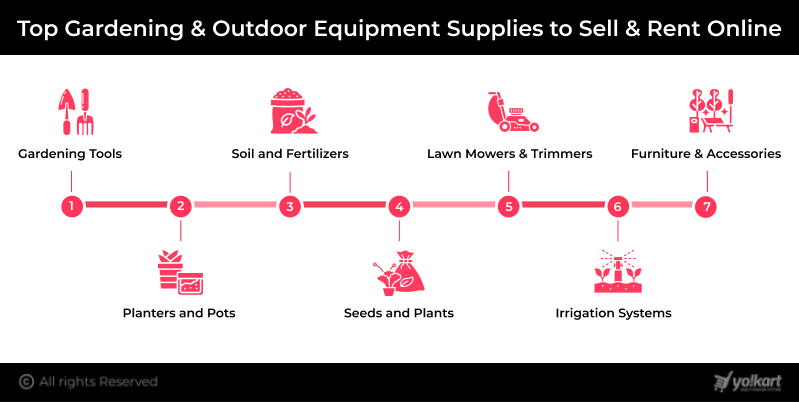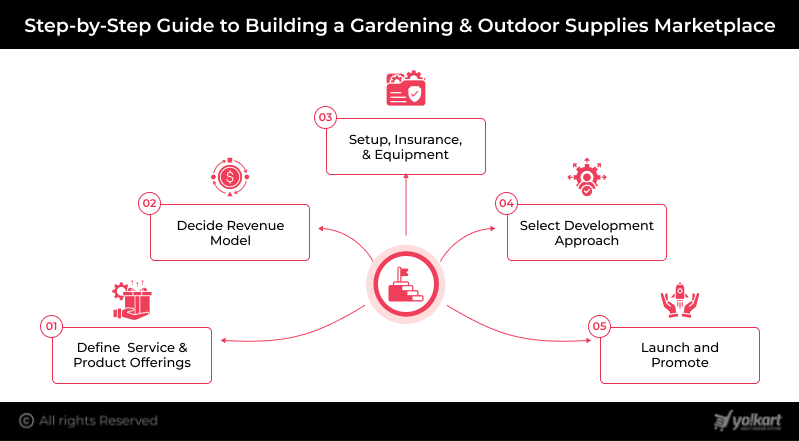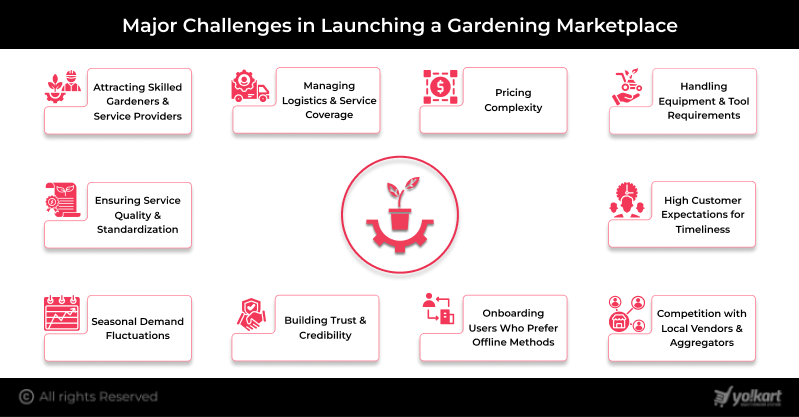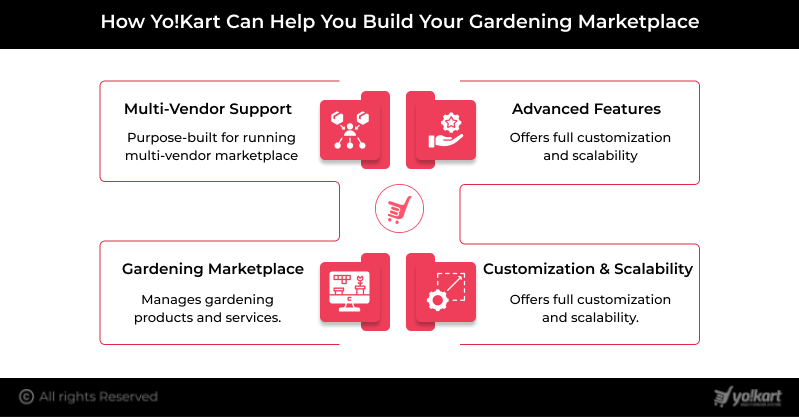Published Date 24 Nov 2025
Gardening is not just one of the oldest and most rewarding hobbies in the world, but also a multi-billion-dollar industry. With people increasingly turning to their yards and outdoor spaces for relaxation, beauty, and sustainability, this industry is growing rapidly. According to Statista, the global gardening equipment market size is projected to reach USD 138.90 billion by 2030, growing at a CAGR of 6.3% from 2025 to 2030. It depicts that, as the interest in gardening grows, so does the potential for businesses catering to this market.
Whether you’re an experienced gardener or someone with a passion for green spaces, starting a gardening business can be both fulfilling and profitable. This blog will take you through the essential steps to establish a successful gardening business, from setting up shop to marketing your products and services.
Table of Contents
- How Profitable is Starting a Gardening and Outdoor Supplies Marketplace?
- Top Gardening and Outdoor Equipment Supplies to Sell and Rent Online
- Step-by-Step Guide to Building a Gardening and Outdoor Supplies Marketplace
- Major Challenges in Launching a Gardening Marketplace
- How Yo!Kart Can Help you Build Your Gardening Marketplace
- Conclusion
- FAQs
How Profitable is Starting a Gardening and Outdoor Supplies Marketplace?
Starting a gardening business taps into a market characterized by evergreen demand. Whether it’s lawn care, landscape design, or selling essential equipment, the need for these services and products is constant, often recurring, and recession-resistant.
The Profit Potential
Yes, a gardening business is definitely profitable when structured and managed correctly. However, profitability can vary significantly based on your business model, specialization, and operational efficiency.
- Service-Based Profitability: Businesses focusing on high-value services like custom landscape design, specialized pruning, or year-round subscription maintenance plans often achieve higher profit margins, sometimes ranging from 15% to over 30% net profit. The cost of goods sold (COGS) is primarily labor, which, when managed efficiently through optimized scheduling and client density, leads to robust earnings.
- Product-Based Profitability: Selling gardening supplies, seeds, tools, and accessories online can be highly scalable. The key is sourcing quality products at competitive wholesale prices. eCommerce models can see gross profit margins of 40% to 60% on high-demand, niche, or branded products.
The industry’s strong average annual turnover for landscaping businesses (2030 Projected Market Size: USD 138.90 Billion) underscores the significant earning potential. The shift toward sustainable, eco-friendly, and tech-enabled gardening further provides opportunities for premium pricing and differentiation.
Top Gardening and Outdoor Equipment Supplies to Sell and Rent Online
Whether you’re offering gardening tools, supplies, or rental equipment, knowing which products to sell or rent can significantly impact your business success. Here are some of the most popular gardening equipment and supplies to consider:

- Gardening Tools: The backbone of any gardening business is a solid range of tools. Some essential gardening tools include shovels, hoes, rakes, shears, and pruners. High-quality tools have long-lasting appeal and are always in demand.
- Planters and Pots: Indoor and outdoor planters are always needed, especially as container gardening becomes more popular. Thus, offering a variety of sizes, shapes, and materials (ceramic, plastic, terracotta) can attract a wide range of customers.
- Soil and Fertilizers: Organic gardening and sustainable practices have sparked a demand for high-quality soil, compost, and fertilizers. Hence, you can create packages tailored to different gardening needs, such as vegetable gardening, flower beds, or lawn care.
- Seeds and Plants: Selling a variety of seeds, including vegetables, flowers, herbs, and even trees, can be a profitable part of your business. You can also partner with nurseries to sell plants or even provide garden design services.
- Lawn Mowers and Trimmers: Larger equipment, such as lawn mowers, weed eaters, and hedge trimmers, is essential for customers with big yards. Renting this equipment instead of selling can be an attractive option for customers who only need them occasionally.
- Irrigation Systems: Watering is crucial for any garden, and offering products like irrigation kits, sprinklers, and rain barrels can help meet the needs of eco-conscious gardeners who want to conserve water.
- Gardening Furniture and Accessories: Items like garden benches, chairs, garden lights, and outdoor storage solutions are an attractive addition to any gardening business. These products can complement other offerings and help create a full-fledged outdoor experience for your customers.
Looking to build a digital hub for gardening products and services?
Step-by-Step Guide to Building a Gardening and Outdoor Supplies Marketplace
Launching a successful gardening venture requires a methodical approach, transitioning from a great idea to a fully operational enterprise.

1. Define Your Service & Product Offerings
The first critical step is deciding on the niche and scope of your business. This choice will dictate everything from your startup costs to your marketing strategy.
Decide on Services You Want to Provide
- Lawn and Garden Maintenance: This is the most common entry point. Services include mowing, weeding, pruning, seasonal clean-ups, and general upkeep. This offers reliable, recurring revenue.
- Landscape Design and Installation: A high-value niche requiring horticultural knowledge and design skills. Focuses on creating and building entirely new outdoor spaces (patios, planting, water features).
- Specialized Services: Arboriculture (Tree Care), Pest and Disease Management (Organic focus is a major trend), Garden Consulting (teaching clients to garden), or Urban/Container Gardening (catering to small spaces). Specialization allows for premium pricing and creates a distinct competitive advantage.
- eCommerce and Supply Sales: Selling physical gardening products and supplies (tools, seeds, soil) through an online platform. This is highly scalable but requires strong logistics.
- Equipment Rental: A lucrative model for high-cost items that homeowners or small-scale gardeners don’t want to purchase outright.
2. Decide Revenue Model
Your revenue model determines how your business makes money. A diversified model can mitigate seasonal risks and maximize market reach.
| Revenue Model | Description |
| Fixed Price/Contract | A single price for a defined project (e.g., installing a new patio, an annual garden design). |
| Hourly Rate/Time & Materials | Billing is based on the time spent and the cost of materials used. |
| Subscription/Retainer | Clients pay a recurring fee (weekly, monthly, seasonally) for guaranteed, ongoing maintenance. |
| eCommerce/Retail | Selling physical goods online or through a retail outlet. Revenue is the selling price minus COGS. |
| Rental Fees | Charging clients daily or weekly fees for the use of heavy equipment. |
| Commission/Marketplace | Taking a percentage cut of sales made by third-party vendors on your platform. |
3. Legal Setup, Insurance, and Equipment
Formalizing your business lends credibility and provides essential protection.
- Business Structure: Choose a legal structure (Sole Proprietorship, LLC, Corporation) to define liability and taxation.
- Licensing & Permits: Check local and state requirements for operating a business, especially for handling chemicals (pesticides, herbicides) or waste disposal.
- Insurance: Critical for a gardening business. You absolutely need Public Liability Insurance to cover property damage or injury that occurs while working. Consider Tools and Equipment Cover and, if you hire staff, Employers’ Liability Insurance.
- Essential Equipment: Start lean, but ensure quality. For service-based work: a reliable vehicle/trailer for transport, a professional-grade mower, trimmer, blower, and high-quality hand tools. For e-commerce, invest in quality packaging and logistics setup.
4. Select Development Approach
A true eCommerce marketplace is a multi-vendor platform. It allows independent sellers (local nurseries, organic seed companies, equipment manufacturers) to register, list, and sell their products or services under your brand. This dramatically increases your product diversity and scale without requiring you to hold physical inventory.
Developing this platform involves a fundamental decision: Custom Build vs. Specialized Software.
1. The Custom Development Approach
This involves hiring a team of developers, designers, and project managers to build the platform from the ground up using code frameworks (like Laravel, Python/Django, or NodeJS).
- Pros (The Control Advantage): You get absolute control over every single feature, UI/UX, and complex business logic. It’s perfectly tailored to your unique niche requirements (e.g., building a highly specific plant hardiness zone filter).
- Cons (The Cost and Time Burden): This is the most expensive and time-consuming path. The initial investment often runs into six figures, and the time-to-market can be 12 to 18 months. Furthermore, you are responsible for testing, maintenance, security, and fixing all bugs, introducing a high long-term technical risk.
2. Readymade eCommerce Marketplace Software Solution:
This involves utilizing a ready-to-launch, commercially available multi-vendor platform solution that is specifically designed to handle the complexity of the marketplace model.
- Pros (The Speed and Reliability Advantage):
- Market-Tested Functionality: These platforms already have the core features necessary for a marketplace (vendor sign-up, commission splits, multi-level catalogs) that have been tested and refined across hundreds of businesses.
- Faster Launch: You can launch a fully functional platform in weeks or a few months, allowing you to validate your business model quickly.
- Cost-Effective Scalability: The upfront cost is significantly lower than custom development, and the platform is built to handle high transactional volume and massive vendor growth.
- Cons:
- Learning Curve: As these platforms are extensive and feature-rich, there is a required learning curve for the marketplace owner and the vendors.
Launch your gardening marketplace with a ready-made solution
5. Launch and Promote
A great platform is nothing without an audience. Thus, you should:
- Soft Launch (Friends & Family/Local Community): Test your platform’s usability, service delivery, and logistics with a small group. Gather feedback and refine.
- Vendor Onboarding Promotion: Offer the first 3-6 months commission-free or at a reduced rate to attract high-quality, diverse vendors for your marketplace.
- Grand Launch Marketing Blitz:
- Local Press & Bloggers: Announce your arrival, focusing on your unique value proposition (e.g., “The one-stop hub for all local, organic gardening needs”).
- PPC/Paid Ads: Target hyper-local searches for services and specific product keywords (e.g., Google Ads, Facebook Ads targeted to local gardening groups).
- Launch Discount/Free Consultation: Offer a compelling incentive for the first 100 customers to drive initial sales and reviews.
Major Challenges in Launching a Gardening Marketplace

1. Attracting Skilled Gardeners & Service Providers
Building a reliable supply side is tough. Experienced gardeners, landscapers, and horticulture experts often rely on offline referrals, making it difficult to convince them to join a new platform.
2. Ensuring Service Quality & Standardization
Gardening services vary widely in technique, tools, and execution. Maintaining consistent service quality across different providers can be challenging without strict guidelines and reviews.
3. Seasonal Demand Fluctuations
Gardening is heavily affected by seasons. Demand peaks in spring and monsoon, but significantly drops during off-seasons. Balancing supply-demand during low-activity months becomes a major obstacle.
4. Managing Logistics & Service Coverage
Gardening is location-based and requires physical presence. Coordinating service availability, travel radius, and time slots can be complex, especially in large cities or rural areas.
5. Building Trust & Credibility
Customers often hesitate to book gardeners online due to lack of trust. They want background-verified professionals, genuine reviews, and transparent pricing—making trust-building a long-term task.
6. Pricing Complexity
Gardening services differ by yard size, plant type, service duration, equipment required, and more. Creating a transparent yet flexible pricing model is a significant challenge.
7. Onboarding Users Who Prefer Offline Methods
Many gardeners and customers still prefer local offline hiring. Converting them into digital users requires strong onboarding support, training, and user-friendly workflows.
8. Handling Equipment & Tool Requirements
Some services need specialized tools (hedge trimmers, leaf blowers, lawn mowers), and not all gardeners carry them. The marketplace must clarify responsibilities and avoid service failures.
9. High Customer Expectations for Timeliness
Gardening tasks are time-sensitive (e.g., pruning, pest control). Delays can affect plant health, leading to customer dissatisfaction and bad reviews.
10. Competition with Local Vendors & Aggregators
Local gardening shops, freelancers, and neighborhood service providers often offer cheaper rates. Differentiating your platform through convenience, quality, and reliability is essential.
How Yo!Kart Can Help You Build Your Gardening Marketplace
If your vision includes building a dominant online presence that unifies the gardening community, connecting growers, suppliers, and service professionals, a purpose-built platform is your most critical asset. For that, you can leverage Yo!Kart, a powerful, self-hosted, multi-vendor eCommerce platform that can serve as the backbone for your ambitious gardening marketplace. Whether you’re looking to sell gardening tools, plants, or services, Yo!Kart offers a comprehensive, scalable solution that can easily accommodate a wide range of products, services, and vendors. With features like customizable storefronts for vendors, real-time inventory management, seamless payment processing, and advanced shipping logistics, Yo!Kart ensures that your marketplace operates smoothly and efficiently.
Here is how Yo!Kart directly addresses the needs of a sophisticated gardening and supply marketplace:

1. Multi-Vendor Functionality
Yo!Kart is architected from the ground up to support a true marketplace model, not just a single store. It has:
- Dedicated Vendor Dashboard: Each nursery, tool supplier, or landscape architect gets their own professional dashboard to manage their listings, inventory, pricing, and orders independently. This is crucial for seamless vendor management and scalability.
- Commission Management: The system automatically calculates and splits payments. You can set varied commission structures (e.g., higher commission for a service booking vs. a product sale), ensuring a profitable revenue stream from day one.
- Vendor Onboarding Tools: Simple, guided registration processes allow you to rapidly grow your vendor base with minimal administrative overhead.
2. All-in-One Gardening Marketplace
The gardening world is a mix of physical goods and skilled services. Yo!Kart can manage both simultaneously:
- Physical Product Catalog: Handles all the complexities of seeds, soil, tools, and heavy equipment with features like advanced inventory tracking and variant management (e.g., different sizes of potting soil).
- Service/Booking Integration: Its customizable nature allows for integrating modules to handle time-slot bookings, scheduling, and service quotes for landscape design or maintenance professionals.
3. Advanced Features
For a niche like gardening, location is everything, from climate zones to local service availability.
- Advanced Geo-Location & Shipping: The platform can handle complex shipping logic, differentiating between standard carrier shipping for small tools and local, zone-based delivery fees for bulk materials or fragile plants, which is essential for vendor sales.
- Multi-Currency and Multi-Language: Prepare your platform for future expansion, allowing you to onboard international vendors or target different linguistic communities.
4. Customization and Scalability
Yo!Kart is a flexible solution designed to grow with your business.
- Source Code Ownership: Unlike SaaS models, you own the source code, giving you the ultimate flexibility to customize every feature to your unique gardening niche, from creating a specific “Plant Hardiness Zone” filter to integrating a custom plant recommendation engine.
- Scalability: Built to handle high traffic and thousands of concurrent transactions, ensuring your platform can support massive growth during peak seasonal demand without crashing.
Thus, leveraging a platform like Yo!Kart, eliminates the need for a multi-million-dollar custom development effort and lets you focus your capital and energy on marketing and vendor acquisition, accelerating your path to market dominance.
See How Yo!Kart Can Power Your Gardening Marketplace
Conclusion
The gardening industry offers a compelling blend of passion, practicality, and undeniable profit potential. By moving beyond the traditional solo-gardener model and embracing the digital landscape, you can tap into a much larger, highly scalable market.
However, the key to unlocking exponential growth lies in creating a unified digital hub. By strategically choosing your niche, adopting a multi-faceted revenue model, and leveraging dedicated eCommerce marketplace software like Yo!Kart, you are not just starting a gardening business; you are cultivating a digital ecosystem. You become the essential connection point for enthusiasts, suppliers, and professionals, effectively positioning your brand as the definitive authority in the blossoming world of horticulture.
FAQs
Q 1. How much time does it take to launch a marketplace for gardening and Outdoor supplies?
Ans. The time taken to launch a marketplace for gardening and Outdoor supplies depends on the development approach and complexity level of the marketplace. With custom development, launching a gardening marketplace typically takes 3 to 6 months, depending on the features and customization required. Whereas pre-built solutions speed up development and allow you to launch the marketplace in a few days to a few weeks.
Q 2. How much does it cost to start a Marketplace For Gardening And Outdoor Supplies?
Ans. The cost to start a marketplace for gardening and outdoor supplies can vary widely. However, if you opt for custom development, it can range anywhere from $10,000 to $250,000+, depending on the scale, features, and complexities. On the other hand, a readymade solution such as Yo!Kart offers you packages starting at just $499.
Q 3. Is a gardening marketplace more profitable than selling gardening equipment as a single vendor?
Ans. Yes, a gardening marketplace can be more profitable than selling gardening equipment as a single vendor. A marketplace allows you to scale quickly by connecting multiple suppliers, diversifying product offerings, and generating revenue from commissions. Moreover, it offers long-term growth potential compared to the limited reach of a single vendor model.




